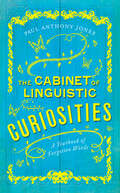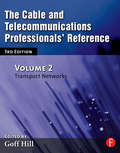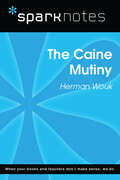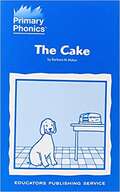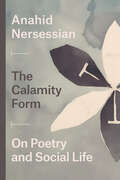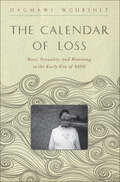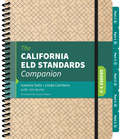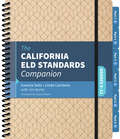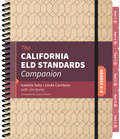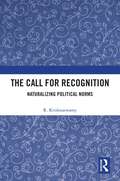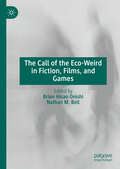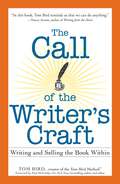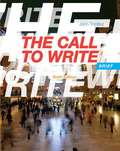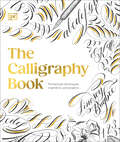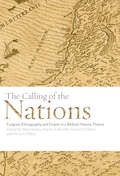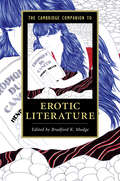- Table View
- List View
The Cabinet of Linguistic Curiosities: A Yearbook of Forgotten Words
by Paul Anthony JonesOpen The Cabinet of Linguistic Curiosities and you’ll find both a word and a day to remember, every day of the year. Each day has its own dedicated entry, on which a curious or notable event—and an equally curious or notable word—are explored. On the day on which flirting was banned in New York City, for instance, you’ll discover why to “sheep’s-eye” someone once meant to look at them amorously. On the day on which a disillusioned San Franciscan declared himself Emperor of the United States, you’ll find the word “mamamouchi,” a term for people who consider themselves more important than they truly are. And on the day on which George Frideric Handel completed his 259-page Messiah after twenty-four days of frenzied work, you’ll see why a French loanword, literally meaning “a small wooden barrow,” is used to refer to an intense period of work undertaken to meet a deadline. The English language is vast enough to supply us with a word for every occasion—and this linguistic “wunderkammer” is here to prove precisely that. So whatever date this book has found its way into your hands, there’s an entire year’s worth of linguistic curiosities waiting to be found.
The Cable and Telecommunications Professionals' Reference: PSTN, IP and Cellular Networks, and Mathematical Techniques (Telecommunications Engineer's Reference Book Ser.)
by Goff HillThis book is for any telecommunications-convergence professional who needs to understand the structure of the industry, the structure of telephony networks and services, and the equipment involved.With the growing variety of networks and technologies now on offer it is inevitable that some convergence will take place between different networks, services and products. New VOIP (voice over internet protocol) networks must interwork with traditional networks. For instance, mobile phones can offer data services; wireless broadband connections to laptops will allow VOIP phone calls away from base; users could have the option of 'convergent phones' that can be used on a landline when at home or business, but which can be used as a mobile when on the move, and so on.
The Cable and Telecommunications Professionals' Reference: Transport Networks (Telecommunications Engineer's Reference Book Ser.)
by Goff HillVolume 2 of TERB 3ed covers the convergence of telephony and data transport, including wireless networks. Now that data is becoming the predominant source of traffic more efficient multiplexing schemes and more flexible control methods are needed in the transport network, such as giving the customer the ability to call for bandwidth on demand. With the development of control methods for switched data services it is now recognised that improved ways to control the transport network are possible and standards initiatives are taking place to establish and improve the network control layer. Detailed explanation of propagation in wireless and optical fibre systems requires a substantial amount of mathematics, also covered in this volume. For each of the math chapters there is an explanation of why the mathematics is important, where it is applied and references to other chapters.
The Caine Mutiny (SparkNotes Literature Guide Series)
by SparkNotesThe Caine Mutiny (SparkNotes Literature Guide) by Herman Wouk Making the reading experience fun! Created by Harvard students for students everywhere, SparkNotes is a new breed of study guide: smarter, better, faster.Geared to what today's students need to know, SparkNotes provides:chapter-by-chapter analysis explanations of key themes, motifs, and symbols a review quiz and essay topicsLively and accessible, these guides are perfect for late-night studying and writing papers.
The Calamity Form: On Poetry and Social Life
by Anahid NersessianRomanticism coincided with two major historical developments: the Industrial Revolution, and with it, a turning point in our relationship to the earth, its inhabitants, and its climate. Drawing on Marxism and philosophy of science, The Calamity Form shines new light on Romantic poetry, identifying a number of rhetorical tropes used by writers to underscore their very failure to make sense of our move to industrialization. Anahid Nersessian explores works by Friedrich Hölderlin, William Wordsworth, John Keats, and others to argue that as the human and ecological costs of industry became clear, Romantic poetry adopted formal strategies—among them parataxis, the setting of elements side by side in a manner suggestive of postindustrial dissonance, and apostrophe, here an address to an absent or vanishing natural environment—as it tried and failed to narrate the calamities of capitalism. These tropes reflect how Romantic authors took their bewilderment and turned it into a poetics: a theory of writing, reading, and understanding poetry as an eminently critical act. Throughout, Nersessian pushes back against recent attempts to see literature as a source of information on par with historical or scientific data, arguing instead for an irreducibility of poetic knowledge. Revealing the ways in which these Romantic works are of their time but not about it, The Calamity Form ultimately exposes the nature of poetry’s relationship to capital—and capital’s ability to hide how it works.
The Calendar of Loss: Race, Sexuality, and Mourning in the Early Era of AIDS (The <I>Callaloo</I> African Diaspora Series)
by Dagmawi WoubshetA revelatory examination of AIDS mourning at the intersection of black and queer studies.His world view colored by growing up in 1980s Ethiopia, where death governed time and temperament, Dagmawi Woubshet offers a startlingly fresh interpretation of melancholy and mourning during the early years of the AIDS epidemic in The Calendar of Loss.When society denies a patient's disease and then forbids survivors mourning rites, how does a child bear witness to a parent's death or a lover grieve for his beloved? Looking at a range of high and popular works of grief—including elegies, eulogies, epistles to the dead, funerals, and obituaries—Woubshet identifies a unique expression of mourning that emerged in the 1980s and early 1990s in direct response to the AIDS catastrophe. What Woubshet dubs a "poetics of compounding loss" expresses what it was like for queer mourners to grapple with the death of lovers and friends in rapid succession while also coming to terms with the fact of their own imminent mortality. The time, consolation, and closure that allow the bereaved to get through loss were for the mourners in this book painfully thwarted, since with each passing friend, and with mounting numbers of the dead, they were provided with yet more evidence of the certain fatality of the virus inside them. Ultimately, the book argues, these disprized mourners turned to their sorrow as a necessary vehicle of survival, placing open grief at the center of art and protest, insisting that lives could be saved through the very speech acts precipitated by death. An innovative and moving study, The Calendar of Loss illuminates how AIDS mourning confounds and traverses how we have come to think about loss and grief, insisting that the bereaved can confront death in the face of shame and stigma in eloquent ways that also imply a fierce political sensibility and a longing for justice.
The California ELD Standards Companion, Grades 3-5: Grades 3-5
by Ivannia Soto Linda J. Carstens James R. BurkeFor California teachers only! Here at last is that single teaching resource for making the critical link between the ELD Standards and the CCSS ELA Standards. Standard by standard, you’ll quickly discover how to integrate language development into your day-to-day content instruction, fully armed with an insider’s understanding of how best to support our many ELs. Horizontal and vertical views reveal how each ELD Standard changes and progresses by grade and proficiency level. What the Student Does sections unpack what meeting a standard looks like in practice. CCSS ELA Standards are displayed side by side with California’s ELD Standards so you can appreciate the purposeful alignment. What the Teacher Does sections provide specific instructional guidance.
The California ELD Standards Companion, Grades 3-5: Grades 3-5
by Ivannia Soto Linda J. Carstens James R. BurkeFor California teachers only! Here at last is that single teaching resource for making the critical link between the ELD Standards and the CCSS ELA Standards. Standard by standard, you’ll quickly discover how to integrate language development into your day-to-day content instruction, fully armed with an insider’s understanding of how best to support our many ELs. Horizontal and vertical views reveal how each ELD Standard changes and progresses by grade and proficiency level. What the Student Does sections unpack what meeting a standard looks like in practice. CCSS ELA Standards are displayed side by side with California’s ELD Standards so you can appreciate the purposeful alignment. What the Teacher Does sections provide specific instructional guidance.
The California ELD Standards Companion, Grades 9-12: Grades K-2
by Ivannia Soto Linda J. Carstens James R. Burke“This is an era of extraordinary promise and support for addressing the needs of California’s English learners. That’s why this book, The California ELD Standards Companion, is so important. It’s exactly the kind of bridge teachers need between standards and what it looks like in the classroom.” —LAURIE OLSEN, Strategic Adviser, The Sobrato Early Academic Language (SEAL) Initiative California teachers: you’re going to love this! Here at last is that single teaching resource for making the critical link between our ELD Standards and the CCSS ELA Standards. Standard by standard, you’ll quickly discover how to integrate language development into your day-to-day content instruction, armed with an insider’s understanding of how best to support our many English learners. Modeled after Jim Burke’s Common Core series, this Grades 9-12 volume of The California ELD Standards Companion is every bit “that version of the standards you wish you had” because it’s just so easy to digest and apply. It’s all here: Horizontal and vertical views reveal how each ELD Standard changes and progresses grade by grade and proficiency level by proficiency level. What the Student Does Sections, also scannable by grade and proficiency level, unpack in student-friendly language what meeting a standard looks like in practice. CCSS ELA Standards are displayed side by side with California’s ELD Standards so you can appreciate the purposeful alignment between the two as the basis for remodeling instructional practice. What the Teacher Does Sections provide specific instructional guidance by grade band, including student prompts and tips for differentiation across proficiency level. A dedicated vocabulary section offers a quick-reference glossary of key words and phrases as they are used within each ELD Standard. Each section concludes with a vignette from the California ELA/ELD Framework to illustrate exemplary standards-based instruction. Thanks to the ELD Standards, we are now free to teach our ELs the way we knew best all along: language and content taught hand in hand across the school day. Lean on Ivannia Soto and Linda Carstens’ California ELD Standards Companion as your one-stop guide for delivering that excellent education our ELs so deeply deserve.
The California ELD Standards Companion, Grades 9-12: Grades K-2
by Ivannia Soto Linda J. Carstens James R. Burke“This is an era of extraordinary promise and support for addressing the needs of California’s English learners. That’s why this book, The California ELD Standards Companion, is so important. It’s exactly the kind of bridge teachers need between standards and what it looks like in the classroom.” —LAURIE OLSEN, Strategic Adviser, The Sobrato Early Academic Language (SEAL) Initiative California teachers: you’re going to love this! Here at last is that single teaching resource for making the critical link between our ELD Standards and the CCSS ELA Standards. Standard by standard, you’ll quickly discover how to integrate language development into your day-to-day content instruction, armed with an insider’s understanding of how best to support our many English learners. Modeled after Jim Burke’s Common Core series, this Grades 9-12 volume of The California ELD Standards Companion is every bit “that version of the standards you wish you had” because it’s just so easy to digest and apply. It’s all here: Horizontal and vertical views reveal how each ELD Standard changes and progresses grade by grade and proficiency level by proficiency level. What the Student Does Sections, also scannable by grade and proficiency level, unpack in student-friendly language what meeting a standard looks like in practice. CCSS ELA Standards are displayed side by side with California’s ELD Standards so you can appreciate the purposeful alignment between the two as the basis for remodeling instructional practice. What the Teacher Does Sections provide specific instructional guidance by grade band, including student prompts and tips for differentiation across proficiency level. A dedicated vocabulary section offers a quick-reference glossary of key words and phrases as they are used within each ELD Standard. Each section concludes with a vignette from the California ELA/ELD Framework to illustrate exemplary standards-based instruction. Thanks to the ELD Standards, we are now free to teach our ELs the way we knew best all along: language and content taught hand in hand across the school day. Lean on Ivannia Soto and Linda Carstens’ California ELD Standards Companion as your one-stop guide for delivering that excellent education our ELs so deeply deserve.
The California ELD Standards Companion: Grades 6-8
by Jim Burke Ivannia Soto Linda CarstensCalifornia teachers: you’re going to love this! Here at last is that single teaching resource for making the critical link between our ELD Standards and the CCSS ELA Standards. Standard by standard, you’ll quickly discover how to integrate language development into your day-to-day content instruction, armed with an insider’s understanding of how best to support our many English learners. Modeled after Jim Burke’s Common Core series, this Grades 6-8 volume of The California ELD Standards Companion is every bit “that version of the standards you wish you had” because it’s just so easy to digest and apply. It’s all here: Horizontal and vertical views reveal how each ELD Standard changes and progresses grade by grade and proficiency level by proficiency level. What the Student Does Sections, also scannable by grade and proficiency level, unpack in student-friendly language what meeting a standard looks like in practice. CCSS ELA Standards are displayed side by side with California’s ELD Standards so you can appreciate the purposeful alignment between the two as the basis for remodeling instructional practice. What the Teacher Does Sections provide specific instructional guidance by grade band, including student prompts and tips for differentiation across proficiency level. A dedicated vocabulary section offers a quick-reference glossary of key words and phrases as they are used within each ELD Standard. Each section concludes with a vignette from the California ELA/ELD Framework to illustrate exemplary standards-based instruction. Thanks to the ELD Standards, we are now free to teach our ELs the way we knew best all along: language and content taught hand in hand across the school day. Lean on Ivannia Soto and Linda Carstens’ California ELD Standards Companion as your one-stop guide for delivering that excellent education our ELs so deeply deserve.
The California ELD Standards Companion: Grades 6-8
by Jim Burke Ivannia Soto Linda CarstensCalifornia teachers: you’re going to love this! Here at last is that single teaching resource for making the critical link between our ELD Standards and the CCSS ELA Standards. Standard by standard, you’ll quickly discover how to integrate language development into your day-to-day content instruction, armed with an insider’s understanding of how best to support our many English learners. Modeled after Jim Burke’s Common Core series, this Grades 6-8 volume of The California ELD Standards Companion is every bit “that version of the standards you wish you had” because it’s just so easy to digest and apply. It’s all here: Horizontal and vertical views reveal how each ELD Standard changes and progresses grade by grade and proficiency level by proficiency level. What the Student Does Sections, also scannable by grade and proficiency level, unpack in student-friendly language what meeting a standard looks like in practice. CCSS ELA Standards are displayed side by side with California’s ELD Standards so you can appreciate the purposeful alignment between the two as the basis for remodeling instructional practice. What the Teacher Does Sections provide specific instructional guidance by grade band, including student prompts and tips for differentiation across proficiency level. A dedicated vocabulary section offers a quick-reference glossary of key words and phrases as they are used within each ELD Standard. Each section concludes with a vignette from the California ELA/ELD Framework to illustrate exemplary standards-based instruction. Thanks to the ELD Standards, we are now free to teach our ELs the way we knew best all along: language and content taught hand in hand across the school day. Lean on Ivannia Soto and Linda Carstens’ California ELD Standards Companion as your one-stop guide for delivering that excellent education our ELs so deeply deserve.
The California ELD Standards Companion: Grades K-2
by Jim Burke Ivannia Soto Linda CarstensJust for California teachers! California teachers: you’re going to love this! Here at last is that single teaching resource for making the critical link between our ELD Standards and the CCSS ELA Standards. Standard by standard, you’ll quickly discover how to integrate language development into your day-to-day content instruction, armed with an insider’s understanding of how best to support our many English learners. Modeled after Jim Burke’s Common Core series, this Grades K-2 volume of The California ELD Standards Companion is every bit “that version of the standards you wish you had” because it’s just so easy to digest and apply. It’s all here: Horizontal and vertical views reveal how each ELD Standard changes and progresses grade by grade and proficiency level by proficiency level. What the Student Does Sections, also scannable by grade and proficiency level, unpack in student-friendly language what meeting a standard looks like in practice. CCSS ELA Standards are displayed side by side with California’s ELD Standards so you can appreciate the purposeful alignment between the two as the basis for remodeling instructional practice. What the Teacher Does Sections provide specific instructional guidance by grade band, including student prompts and tips for differentiation across proficiency level. A dedicated vocabulary section offers a quick-reference glossary of key words and phrases as they are used within each ELD Standard. Each section concludes with a vignette from the California ELA/ELD Framework to illustrate exemplary standards-based instruction. Thanks to the ELD Standards, we are now free to teach our ELs the way we knew best all along: language and content taught hand in hand across the school day. Lean on Ivannia Soto and Linda Carstens’ California ELD Standards Companion as your one-stop guide for delivering that excellent education our ELs so deeply deserve.
The California ELD Standards Companion: Grades K-2
by Jim Burke Ivannia Soto Linda CarstensJust for California teachers! California teachers: you’re going to love this! Here at last is that single teaching resource for making the critical link between our ELD Standards and the CCSS ELA Standards. Standard by standard, you’ll quickly discover how to integrate language development into your day-to-day content instruction, armed with an insider’s understanding of how best to support our many English learners. Modeled after Jim Burke’s Common Core series, this Grades K-2 volume of The California ELD Standards Companion is every bit “that version of the standards you wish you had” because it’s just so easy to digest and apply. It’s all here: Horizontal and vertical views reveal how each ELD Standard changes and progresses grade by grade and proficiency level by proficiency level. What the Student Does Sections, also scannable by grade and proficiency level, unpack in student-friendly language what meeting a standard looks like in practice. CCSS ELA Standards are displayed side by side with California’s ELD Standards so you can appreciate the purposeful alignment between the two as the basis for remodeling instructional practice. What the Teacher Does Sections provide specific instructional guidance by grade band, including student prompts and tips for differentiation across proficiency level. A dedicated vocabulary section offers a quick-reference glossary of key words and phrases as they are used within each ELD Standard. Each section concludes with a vignette from the California ELA/ELD Framework to illustrate exemplary standards-based instruction. Thanks to the ELD Standards, we are now free to teach our ELs the way we knew best all along: language and content taught hand in hand across the school day. Lean on Ivannia Soto and Linda Carstens’ California ELD Standards Companion as your one-stop guide for delivering that excellent education our ELs so deeply deserve.
The Call Me Ishmael Phone Book: An Interactive Guide to Life-Changing Books
by Logan Smalley Stephanie KentFor fans of My Ideal Bookshelf and Bibliophile, The Call Me Ishmael Phone Book is the perfect gift for book lovers everywhere: a quirky and entertaining interactive guide to reading, featuring voicemails, literary Easter eggs, checklists, and more, from the creators of the popular multimedia project.The Call Me Ishmael Phone Book is an interactive illustrated homage to the beautiful ways in which books bring meaning to our lives and how our lives bring meaning to books. Carefully crafted in the style of a retro telephone directory, this guide offers you a variety of unique ways to connect with readers, writers, bookshops, and life-changing stories. In it, you&’ll discover... -Heartfelt, anonymous voicemail messages and transcripts from real-life readers sharing unforgettable stories about their most beloved books. You&’ll hear how a mother and daughter formed a bond over their love for Erin Morgenstern&’s The Night Circus, or how a reader finally felt represented after reading Gene Luen Yang&’s American Born Chinese, or how two friends performed Mary Oliver&’s Thirst to a grove of trees, or how Anne Frank inspired a young writer to continue journaling. -Hidden references inside fictional literary adverts like Ahab&’s Whale Tours and Miss Ophelia&’s Psychic Readings, and real-life literary landmarks like Maya Angelou City Park and the Edgar Allan Poe House & Museum. -Lists of bookstores across the USA, state by state, plus interviews with the book lovers who run them. -Various invitations to become a part of this book by calling and leaving a bookish voicemail of your own. -And more! Quirky, nostalgic, and full of heart, The Call Me Ishmael Phone Book is a love letter to the stories that change us, connect us, and make us human.
The Call for Recognition: Naturalizing Political Norms
by R. KrishnaswamyThis book builds a case for how social norms are neither mere conventions nor are they merely anthropological phenomena, which are relativistic. In other words, it talks about how socio-political norms are built out of our natural social behaviour but at the same time also have objective normative validity. The volume puts forth an alternative model called the recognitional model which can help us address some of the socio-political concerns we face in today’s world. It addresses the problem with a purely legalistic framework of addressing social injustice in that law, due its universalistic assumptions, regarding human nature, tends to glide over the particular differences that might exist between people. This book discusses how we know that in our daily lives, we value people not only because that person is a legal human being but also because that person is our father, mother, our teacher, etc. There is a whole network of acts of social respect that we engage in with the other in our social sphere which the legal framework can’t quite capture. This volume sheds light on the political consequence of legal reasoning in that it is formalistic in the sense that legal relations can’t successfully codify the immediate epistemic context from which social identities emerge. An introspective work, this book will be of great interest to scholars and researchers of linguistics, political philosophy, law and human rights, and social theory.
The Call of the Eco-Weird in Fiction, Films, and Games
by Brian Hisao Onishi Nathan M. BellThis edited volume identifies and analyses the Eco-Weird as an interdisciplinary theoretical tool for engaging in fictional, philosophical, filmic, and ludic texts. It is the first volume to engage in the study of the Eco-Weird, which is a developing field at the intersection of environmental thought and Weird fiction, broadly construed to include literature, games, films, art, and television shows. The Eco-Weird has intersections with other literary and scholarly fields, including horror studies, game studies, phenomenology, literary criticism, and eco-criticism, but provides a unique set of tools to engage both its texts and the ongoing environmental crises of climate change, environmental justice, pollution, and more.
The Call of the Tribe
by Mario Vargas LlosaThe intellectual autobiography of Mario Vargas Llosa, winner of the Nobel Prize in Literature.From its origins, the liberal doctrine has represented the most advanced forms of democratic culture, and it is what has most defended us from the inextinguishable “call of the tribe.” This book hopes to make a modest contribution to that indispensable project.In The Call of the Tribe, Mario Vargas Llosa surveys the readings that have shaped the way he thinks and has viewed the world over the past fifty years. The Nobel laureate, “tireless in his quest to probe the nature of the human animal” (Marie Arana, The Washington Post), maps out the liberal thinkers who helped him develop a new body of ideas after the great ideological traumas of his disenchantment with the Cuban Revolution and his alienation from the ideas of Jean-Paul Sartre, the author who most inspired Vargas Llosa in his youth.The works of Adam Smith, José Ortega y Gasset, Friedrich A. Hayek, Karl Popper, Raymond Aron, Isaiah Berlin, and Jean-François Revel helped the author enormously during those uneasy years. They showed him another school of thought, one that placed the individual before the tribe, nation, class, or party and defended freedom of expression as a fundamental value for the exercise of democracy. The Call of the Tribe documents Vargas Llosa’s engagement with their work and charts the evolution of his personal ideology.
The Call of the Writer's Craft: Writing and Selling the Book Within
by Tom BirdGetting a book successfully published is as much about talent and creative drive as it is a matter of determination and business practice. Luckily for would-be authors, this book delivers the how-to on both the creativity and the business.Lecturer and writing retreat leader Tom Bird introduces authors to their Divine Author Within, and guides them through the process of listening to this inner muse. They will learn how to tap into their "creative connected mind" and relax their "logical critical mind" so they will be able to write the book they've always wanted to--in just two drafts!Once the book is complete, writers learn how to sell their book. Bird instructs his readers how to successfully navigate the publishing world so that they can make the right choices for their work.
The Call to Write (Brief Sixth Edition)
by John TrimburThe brief sixth edition of THE CALL TO WRITE continues and expandes its creative approach to college composition. Organized by genres, including letters, memoirs, profiles, reports, commentaries, proposals, and reviews, and including new chapters on the essay and on multigenre writing, this innovative rhetoric gives students the practice they need to write in college and in the public sphere. Timely, provocative readings promote social engagement, encouraging students to become involved, through public writing, in their community and in the greater world around them.
The Calligraphy Book: Pointed Pen Techniques, Inspiration, and Projects
by Lindsey BugbeeMaster modern calligraphy and create stunning invitations, artworks, and labels with this essential guide from The Postman's Knock. This all-in-one guide reveals the secret to creating stunning letter art, with essential tips, expert advice, and inspiring projects from Lindsey Bugbee, the creator of The Postman’s Knock, the world’s number one calligraphy website. Discover the tools you need to achieve the best results: not only pens, nibs, inks, and paper, but also patience and creativity as you build up your confidence and skills. Follow step-by-step guides to Lindsey's favorite lettering styles, then put your new-found skills to use with 15 inspiring projects, including ideas for unique invitations and cards for loved ones. With a little time, practice, and a little ink, you'll be amazed at what you can create.
The Calling of the Nations
by Mark Vessey Robert Daum Sharon Betcher Harry O. MaierCurrent notions of nationhood, communal identity, territorial entitlement, and collective destiny are deeply rooted in historic interpretations of the Bible. Interweaving elements of history, theology, literary criticism, and cultural theory, the essays in this volume discuss the ways in which biblical understandings have shaped Western - and particularly European and North American - assumptions about the nature and meaning of the nation.Part of the Green College Lecture Series, this wide-ranging collection moves from the earliest Pauline and Rabbinic exegesis through Christian imperial and missionary narratives of the late Roman, medieval, and early modern periods to the entangled identity politics of 'mainstream' nineteenth-and twentieth-century North America. Taken together, the essays show that, while theories of globalization, postmodernism, and postcolonialism have all offered critiques of identity politics and the nation-state, the global present remains heavily informed by biblical-historical intuitions of nationhood.
The Cambridge Companion To Beckett
by John PillingThe world fame of Samuel Beckett is due to a combination of high academic esteem and immense popularity. An innovator in prose fiction to rival Joyce, his plays have been the most influential in modern theatre history. As an author in both English and French and a writer for the page and the stage, Beckett has been the focus for specialist treatment in each of his many guises, but there have been few attempts to provide a conspectus view. This book provides thirteen introductory essays on every aspect of Beckett's work, some paying particular attention to his most famous plays (e. g. Waiting for Godot and Endgame) and his prose fictions (e. g. the 'trilogy' and Murphy). Other essays tackle his radio and television drama, his theatre directing and his poetry, followed by more general issues such as Beckett's bilingualism and his relationship to the philosophers. Reference material is provided at the front and back of the book.
The Cambridge Companion To Erotic Literature (Cambridge Companions to Literature)
by Mudge Bradford K.The Cambridge Companion to Erotic Literature offers an introduction to key debates in the study of erotic literature from antiquity to the present. It addresses one of the longest standing controversies in literary history: the boundary between acceptable and unacceptable treatments of human sexuality. Whether scurrilous Roman satire, irreverent Restoration drama, or bold Modernist novel, erotic literature pushes the boundaries of the acceptable and challenges the conventions of more mainstream literatures. In fifteen chapters that range from ancient Greece and Rome to twentieth-century American, English, French, and Dutch literature, experts in the field confront a variety of related topics, such as the definition and scope of erotic literature, the nature of textual pleasure, historical shifts in the understanding of the normal and the perverse, the relationship between gender and genre, sexual violence, homosexuality, sadomasochism, necrophilia, satire, pornography, etc. Students new to the scholarship are provided with a clear and useful introduction; those already familiar with the field are given an exciting glimpse into the most recent work.
